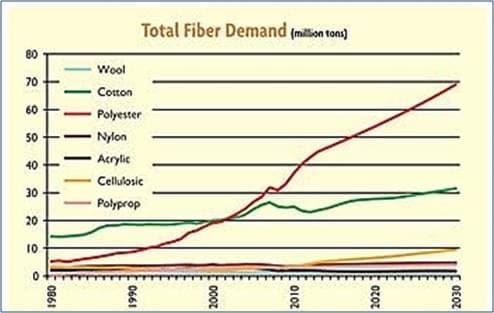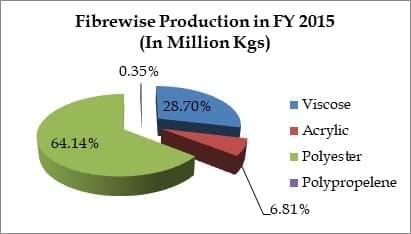Introduction
Indian textile industry is dominated by cotton since ancient times because of abundant availability of the fibre in India. But, today our fashion dynamics have changed. Indian fashion industry is responding to global fashion trends. In fact our clothing style has tremendous impact of western styles. If we go 50 years back, there is hardly any fashion awareness in common population. The fashion was mostly limited to only film stars. But today, India has shown a fashion evolution. Kids & middle-aged are equally fashion conscious as youngsters. Our designers are exploring with fibres other than cotton.
Polyester in Fashion
The PET used in fabrics by the fashion industry was invented in 1941 by John Whinfield and James Dickson, two chemists in the UK who developed PET in response to the invention of nylon a few years earlier. Chemical manufacturing giant DuPont purchased the rights to their invention, known as Terylene at the time, and eventually developed their own version, Dacron, in the early 1950s. This endorsement by DuPont, along with the fact that the key ingredient petroleum was readily accessible in the middle of the 20th century, opened up the use of PET to the fashion industry and started the trend of using polyester in dresses.
Global Scenario
The graph shows the history of fiber demand in millions of tons, and demonstrates the dominant role that polyester has had in fiber demand growth. The graph also shows the continuing dominance of polyester going forward, as calculated by England-based PCI Fibres in its forecast out to 2030. Polyester demand passed that of cotton in 2002, and has continued to grow at a significantly faster rate than all other fiber types.
A very large part of the growth in polyester has come from China with India and Southeast Asia also contributing. In the case of China, both polyester production and apparent domestic demand for the fiber have been very strong. China accounts for 69 percent of all polyester fiber production globally, and if India and Southeast Asia are added, these three regions represent 86 percent of global production. Polyester is dominant, but nylon, the oldest MMF, still plays an important role in the fiber business with 4 million tons of global production in 2014.
Indian Polyester Market Scenario
Globally the fibre consumption ratio is at 40:60 for natural and man-made fibre where polyester is major MMF fibre consumed. However, in India it is reverse at 60:40. The demand for MMF from textile sector will largely be driven by the growing demand for clothing along with the augmented demand for the home textiles and technical textiles. Polyester alone accounted for approximately 66% of the total MMF consumption in FY15. The widening price differential between cotton and polyester and growth in use of non-cotton spun yarn and fabrics will drive the demand for polyester in India. The polyester segment consumption can be segregated into PFY – 63% and PSF – 37%. The PSF industry is highly organised with only three players – Reliance Industries, Indo Rama Synthetics and Bombay Dyeing. In PFY segment, RIL is the largest manufacturer accounting for about 55% of the total domestic production and Century Enka, Indo Rama Synthetics, Alok Industries, Garden Silk, JBF Industries are some other significant players.
Properties in Polyester best suited for Garments
Polyester is known for its durability, tremendous resiliency, stain resistance, and wrinkle resistance. Polyester is also capable of retaining a colour dye quite well. In certain applications, this fabric can repel water and aid in the creation of waterproof clothing. Polyester tends to have sheen to it. It does not shrink much, it dries quickly, and it resists mildew well.
Disadvantages of Polyester
- Polyester is not biodegradable, meaning it doesn’t break down in soil & creates landfill. Generally it is used in manufacturing of recycled PET bottles.
- Polyester fabric is non-breathable; hence it doesn’t absorb any sweat. It is not advisable to use polyester clothing during summer.
- But properties of polyester can be enhanced by blending with certain natural fibres or treating it with chemicals.
Innovations in Polyester
With the continuous technology advancement and research & development, the polyester fibres’ properties are enhanced to suit various applications. Classic example is Recron®- a polyester fibre brand of Reliance Industries. It is developed in wide ranges depending on applications like Recron® Easy Stretch, Recron® FR ( Fire retardant), Recron® LP (low-pill tow and fibre), Recron® Super bright, Recron® Dyefast, Recron® Micrelle, Recron® 3S, Recron® Superdye & many more.
Coolmax, a trademark of Invista, is specially-engineered polyester fibre to improve “breathability” compared to natural fibres like cotton. The series of closely spaced channels creates capillary action that wicks moisture through the core and out to a wider area on the surface of the fabric which increases evaporation & now often woven with other materials like cotton, wool, Spandex and Tencel. Properties of CoolMax fabric allows wearer to keep sweat free hence it is widely used in garments of mountain climbing gear, casual sportswear, underwear & mattress covers. Other useful properties include resistance to fading, shrinking and wrinkling.
Several other fibres /yarns are widely used various industrial & other functional applications like dope dyed polyester yarns used in high visibility garments.
Growth drivers for Polyester garments
- Westernisation
Indian fashion industry has very high influence of western fashion. Polyester is majorly consumed fibre in clothings in western countries. Indians are seen quickly adopting most of western fashion trends.
- Easy maintenance
Polyester garments are resistant wrinkles due to fibre’s inherent properties whereas cotton garments tend to wrinkle a lot. so it is blended with natural fibres to enhance its properties like breathability & sweat absorption. It is preferred highly preferred in office wear.
- Trendy Looks
Due to its inherent luster, polyester garments look more stylish & trendy, so it is highly popular amongst designers.
- Strong Fibre
Polyester which is also known as plastic fibre has very high strength; hence the garments are very long lasting & best suited for machine wash
- Cheaper than cotton garments
Polyester garments are cheaper option over cotton garments so preferred
- Growing export market
Polyester has huge growth potential in export market as globally, fibre consumption ratio is at 40:60 for natural and man-made fibre where polyester is major MMF fibre consumed
- High demand of polyester sari & dresses
Polyester Saris & dresses are big market in India & they are main contributor to Indian polyester garment market.
Roadblocks in growth Polyester industry in India
- High Excise duty
- High customs duty
- GST Issues for textile Industry
- Lack of global competitiveness post dismantling of quotas
- Limited number of players
- Levy of anti-dumping duties
Conclusion:
Globally, polyester is the most dominant man-made fibre, with a share of around 77% in total production and consumption of man-made fibres. The polyester has tremendous growth potential in coming future because of changing fashion dynamics of Indian garment industry. To meet huge demands from domestic as well as international markets, India has to gear up in terms of current capacities & fibre policy. Though our current capacities are excess to match the existing demand, it is forecasted that demands will grow exponentially in coming future. So, we certainly need to update our current capacities to match growing future demands.
The national fibre policy needs to lay a special emphasis on improving the competitiveness of Indian man-made fibres and textiles industry as it can drive the growth of the Indian textile industry in the future. This requires addressing of issues and constraints faced by the industry at present and make suitable provisions to avoid any foreseeable hurdles in the future. Some of changes like fibre neutral excise policy, reduction in excise duty & custom duty for MMF, custom duty exemption on certain raw materials & additives which are primarily imported, export oriented incentives can result in high growth of MMF industry.
In true sense, polyester has all the potential to become an universal fibre. It has a lot of potential to adopt and innovate characteristics of other fibres.



